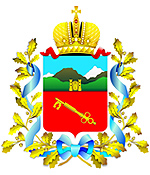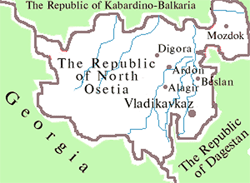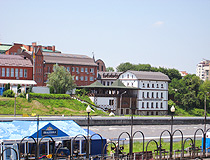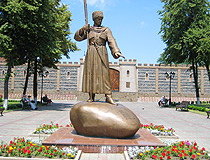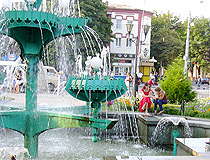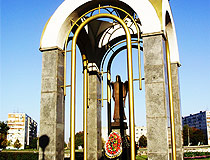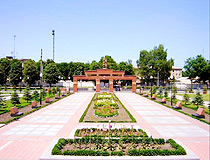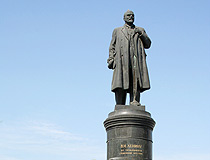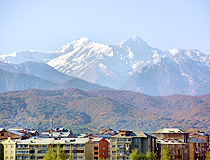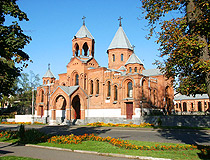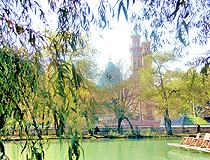Brief History of Vladikavkaz
Foundation of Vladikavkaz
The history of the fortress and the city of Vladikavkaz began in 1784, in connection with the signing of the Treaty of Georgievsk (1783), according to which Georgia passed under the protectorate of the Russian Empire. To establish communication with Georgia, it was necessary to organize transport links and build a line of fortresses in the North Caucasus. Therefore, by order of Empress Catherine II, several fortified outposts were erected on the right bank of the Terek River.
One of them, located near the Darial Gorge, was named Vladikavkaz (“The Ruler of the Caucasus”). The Ossetian settlement of Dzaug was situated next to the fortification. Soon this name also passed to the new fortress, and later to the town founded here. Local residents began to call it Dzaudzhikau (“Dzaug settlement”). An Orthodox church was founded inside and the fortress itself was equipped with twelve cannons.
The first years of the fortress cannot be called successful. New Russian fortresses prevented the Caucasian highlanders from getting slaves in Georgia and reselling them. In 1785, there were several raids on the fortress, which the Russian military garrison could not resist. In 1788, it was decided to withdraw the troops and to destroy the fortress.
More Historical Facts…
Vladikavkaz in the 19th - early 20th centuries
The fortress of Vladikavkaz was rebuilt in 1803. One year later, the authorities formed a specially trained garrison to fight the highlanders. Communication with Georgia was finally established. In 1850, the population of Vladikavkaz was about 3,600 people.
During the Caucasian War of 1817-1864, the fortress was greatly expanded. In 1858, Vladikavkaz was surrounded by a stone wall with loopholes and towers. By the middle of the 19th century, it also became an important regional industrial and trade center. In 1860, Vladikavkaz received the status of a town. In 1863, it became the administrative center of Terek Oblast.
In 1875, the railway to Rostov-on-Don was constructed, which facilitated the rapid development of Vladikavkaz. The town had a favorable geographical position and was the closest place for the sale of goods of local residents - cheese, homespun cloth, grain, furs, livestock, handicrafts, and various products. From here, trains carried a huge amount of wheat, corn and other products to Rostov-on-Don, while the highlanders, in turn, bought the necessary things in the Vladikavkaz markets.
Vladikavkaz also became an important cultural center. It was visited by such famous Russian cultural figures as Pushkin, Lermontov, Chaliapin, Tolstoy, Chekhov, Griboyedov. In 1895, a library was opened in Vladikavkaz, the first in the North Caucasus. At the beginning of the 20th century, a large number of buildings in the Art Nouveau style appeared in the city. In 1914, the population of Vladikavkaz was 79,343 people.
Vladikavkaz during and after Soviet times
From January 20, 1921 to November 7, 1924, Vladikavkaz was the capital of Gorskaya ASSR (The Mountain Autonomous Soviet Socialist Republic). By 1924, only North Ossetia and Ingushetia remained in the Mountain Republic. After the final abolition of the Mountain Republic, the North Ossetian and Ingush autonomous oblasts were created. Vladikavkaz became the capital of both regions, in the status of an autonomous city.
On September 2, 1931, the city of Vladikavkaz was renamed Ordzhonikidze, in honor of Grigory Ordzhonikidze, a Georgian Bolshevik and prominent Soviet politician. On January 15, 1934, the city became the capital of the North Ossetian Autonomous Oblast. The Ingush Autonomous Oblast was merged with the Chechen Autonomous Oblast into the Chechen-Ingush Autonomous Oblast. In 1939, the population of the city was about 130,000 people.
In the fall of 1942, during the Second World War, in the area of Ordzhonikidze, Soviet troops managed to conduct a successful defensive operation and prevent the last attempt of the Germans to break through to the Grozny and Baku oil-bearing regions and to the Transcaucasus. On February 28, 1944, the city of Ordzhonikidze was renamed into Dzaudzhikau.
On February 24, 1954, Dzaudzhikau was renamed back to Ordzhonikidze. In 1984, the population of the city exceeded 300,000 people. On July 20, 1990, the historical name was returned to the city - Vladikavkaz.
In 2007, Vladikavkaz was awarded the honorary title “The City of Military Glory”.
Streets of Vladikavkaz
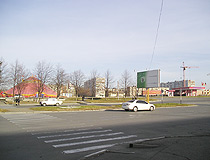
On the street in Vladikavkaz
Author: Radion Hohti
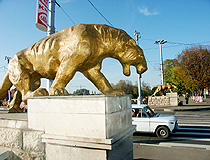
Sculptures of Caucasian leopards on Olginsky (Chugunnyy) Bridge in Vladikavkaz
Author: Kiyanovsky Dmitry
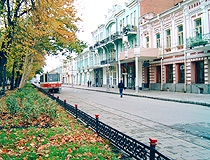
Tram on Mira Avenue - the main street of Vladikavkaz
Author: Golodnyak Alexander
Vladikavkaz - Features
The name of Vladikavkaz literally means “The Ruler of the Caucasus”. It is located on the banks of the Terek River at the foot of the Caucasus Mountains, which are perfectly visible from the city. The height of the city center is about 700 m above sea level.
The climate in Vladikavkaz is rather mild. Summers are usually cool and humid, winters are rather warm and dry. The same climate is typical, for example, for cities at the northern foothills of the Alps. The weather is comfortable almost all year round (although, like other southern cities, from May to September Vladikavkaz looks livelier), so the time of a trip to this city should be tied to your plans in the mountains. The average January temperature is minus 0.7 degrees Celsius, in July - plus 22.5 degrees Celsius.
According to the 2010 all-Russian census, the ethnic composition of the population of Vladikavkaz is following: Ossetians (63.03%), Russians (25.01%), Armenians (3.67%), Georgians (1.94%), Ingush (1.02%).
The local industry is represented by enterprises in the food and light industries, machine building, nonferrous metallurgy, and others. There are two large metallurgical plants and a number of enterprises producing alcoholic beverages in Vladikavkaz.
The Vladikavkaz Airport, located 25 km north of Vladikavkaz, on the eastern outskirts of Beslan, offers regular flights to Moscow, St. Petersburg, and Sochi. The easiest way to get to Vladikavkaz is to fly from Moscow.
The highway R217 “Caucasus”, the main transport artery of the North Caucasus, passes through Beslan, about 20 km north of Vladikavkaz. The Georgian Military Highway, which starts from Vladikavkaz, passes through the Main Caucasian ridge, and connects Vladikavkaz and Tbilisi (Georgia). The entire North Caucasus, major southern cities of Russia (Krasnodar, Stavropol, Volgograd, etc.), as well as Armenia and Georgia have a bus connection with Vladikavkaz. Public transport is represented by trams (since August 1904) and buses.
In Vladikavkaz, a wonderful location at the foot of high mountains on the banks of the turbulent Terek River is combined with well-preserved pre-revolutionary architecture, and the Caucasian traditions - with a cosmopolitan atmosphere. In addition, it stands on the way to Georgia, to the Ossetian mountains, to Chechnya and Ingushetia.
Vladikavkaz is one of the most beautiful cities in the North Caucasus. In general, this city is quite compact. Pre-revolutionary buildings can be found on both banks of the Terek River. Vladikavkaz is a good starting point for trips to mountainous regions of North Ossetia. Their main attractions are available year-round, but mountain climbs are possible only in the summer.
Main Attractions of Vladikavkaz
Mira Avenue - the historic central street of Vladikavkaz starting at Svobody Square and stretching to Kirov Street. Here you can see beautiful mansions with mountains in the background. In the past, most of these buildings belonged to famous merchants or city institutions. Today, almost all of them are architectural monuments.
The only transport on the avenue is a tram. This is a good place for walking and resting, where you can enjoy old architecture, visit museums, and taste Ossetian cuisine.
Park of Culture and Rest named after Kosta Khetagurov - the oldest and one of the best parks in the North Caucasus. The territory of this park, named after the poet, playwright, and founder of Ossetian literature, is divided into upper and lower terraces. The latter rests on the bank of the Terek River, from where magnificent views of the mountain landscapes open.
The upper terrace consists of quiet old avenues with tall trees planted almost 150 years ago, benches, and sculptures. The lower terrace has ponds with picturesque islets and bridges, among which you can ride a boat. There is a Chinese gazebo and a fountain. If you go to the right from the fountain, the modern part of the park begins, which has rides, a Ferris wheel, and a cafe. The terraces are connected by two staircases - one wide and the other more like a forest path with stone steps. Mira Avenue, 2.
National Museum of the Republic of North Ossetia-Alania. The expositions of this museum tell about the history of Alania from ancient times to the present day, the culture and life of the Ossetian people, the flora and fauna of the republic. Here you can see archaeological finds, old tools, jewelry, dishes, furniture, wooden household items, national costumes, weapons, coins, and unique photographs. Mira Avenue, 11.
Art Museum named after Maharbek Tuganov. The picturesque building of this museum was built in the Art Nouveau style in 1903. The main expositions: Russian portrait of the 18th - early 20th centuries, Russian fine art of the late 19th - early 20th centuries, Founders of Ossetian professional art, Naive sculpture of the late 19th - early 20th centuries - Ossetian primitivism, Contemporary fine arts of North Ossetia. Mira Avenue, 12.
Sunni Mosque of Mukhtarov (1900-1908) - one of the most beautiful buildings in Vladikavkaz, striking with the elegance of the exterior and the splendor of the facade decoration. The construction of the mosque cost 80 thousand rubles, of which more than 50 thousand were donated by Murtuza Mukhtarov, the Azerbaijani millionaire-oil industrialist, a prominent patron of arts in the Caucasus. The mosque is located on the left bank of the Terek River and is one of the main symbols of Vladikavkaz, an architectural monument of federal significance. Kotsoyeva Street, 62.
Church of the Nativity of the Blessed Virgin Mary (1823) - the oldest Orthodox church in Vladikavkaz, an object of cultural heritage of the peoples of Russia, a cultural monument of federal significance. Tourists come here to look at the classical architecture of the building and admire the amazing views that open from the territory of the church. Nearby there is a necropolis with the graves of many famous residents of Vladikavkaz. Rozhdestvenskaya Street, 20.
Church of St. Gregory the Enlightener (1864-1868) - a picturesque red-brick Armenian church located on the right bank of the Terek River near Olginsky (Chugunnyy) Bridge. This is one of the few churches where services continued in Soviet times. In 1960, the church received the status of a monument protected by the state. Armyanskaya Street, 1.
Monument to Issa Pliev. This majestic equestrian monument, 10 meters high, depicts the hero of the Soviet Union, Ossetian General Issa Pliev. The monument was installed in the city center on the bank of the Terek River near Olginsky (Chugunnyy) Bridge in 1997. General Pliev Square.
Stolovaya (Table) Mountain - a rather rare mountain for Russia, which is visible from the windows of the buildings of the capitals of two republics at once - North Ossetia-Alania and Ingushetia. It is depicted on the coat of arms of Vladikavkaz. The height of this mountain with a flat top is about 3,000 meters. Remains of sanctuaries of the 4th-18th centuries have been preserved here. To ascend, no special preparation is needed, a convenient path for climbing to the top is located on the side of Ingushetia. The trip from Vladikavkaz will take about 40 minutes.
Monument to Uastyrdzhi. At the entrance to the Alagir Gorge, about 40 km west of Vladikavkaz, you can see a stunningly picturesque sculpture of Uastyrdzhi - the patron saint of men, travelers and warriors, the defender of the weak. One of the largest equestrian monuments in the world, it is located at a height of 22 meters and is literally floating in the air. The monument is attached to the rock with only a part of the stone cloak. Locals believe that if you make a wish while standing right under the sculpture, it will certainly come true.
The City of the Dead (Dargavs) - one of the most famous historical sites of the Republic of North Ossetia-Alania. This monument of culture and history of the 18th century is located on the slope of the Caucasus Mountains about 1 km from the village of Dargavs, 37 km south-west of Vladikavkaz. From a distance, the necropolis resembles an ordinary village. In total, there are more than 90 crypts on its territory. This place is also called “the city of the dead” because in the past whole families with children and old people, who were infected with the plague, came here to die to save their neighbors and loved ones.


